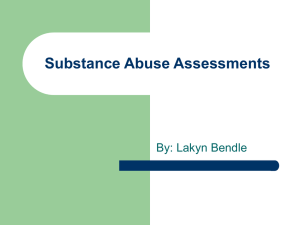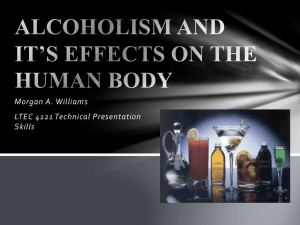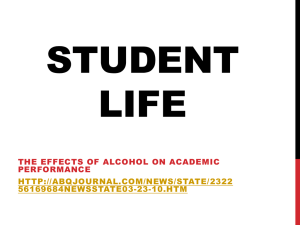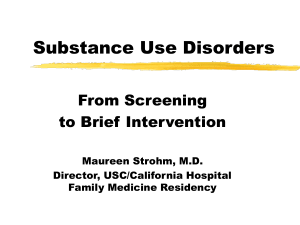Eric Goplerud PowerPoint - National Association of Psychiatric
advertisement
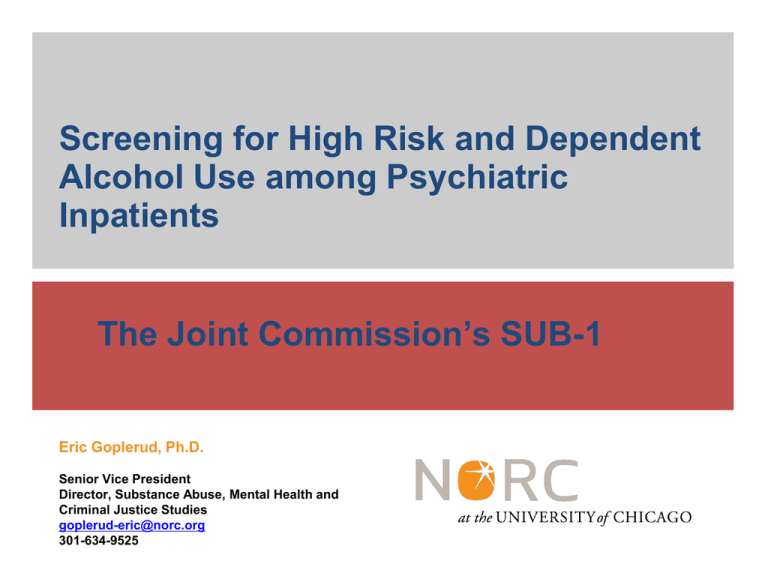
Screening for High Risk and Dependent Alcohol Use among Psychiatric Inpatients The Joint Commission’s SUB-1 Eric Goplerud, Ph.D. Senior Vice President Director, Substance Abuse, Mental Health and Criminal Justice Studies goplerud-eric@norc.org 301-634-9525 Screening for Alcohol Use among Psychiatric Inpatients • Screening refers to a tool – usually a brief questionnaire – that finds subjects who have or are at high risk for a disorder in a population of interest. • Screening does not establish a diagnosis. Instead, it identifies people at risk for or likely to have a disorder • The Joint Commission SUB-1 measure specifies a “validated” screening instrument 2 HOW TO HELP PATIENTS: A CLINICAL APPROACH STEP 1: Ask About Alcohol Use Prescreen: Do you sometimes drink beer, wine, or other alcoholic beverages? If NO… the screening is complete. If YES… Pre-Screen: The NIAAA – Recommended Single Question Alcohol Screener None MEN: WOMEN: 1 or more How many times in the past year have you had 5 or more drinks in a day? How many times in the past year have you had 4 or more drinks in a day? This question was sensitive (87.9%) but less specific (66.8%) for the detection of a current alcohol use disorder. Smith PC, Schmidt SM, Allensworth-Davies D, Saitz R. Primary care validation of a single-question alcohol screening test. J Gen Intern Med. 2009;24:783–788. Supplemented by two-item screener: (1) recurrent drinking in hazardous situations and (2) drinking more than intended. If either answered yes, the sensitivity of current SUD varies from 77% to 95% and the specificity from 62% to 86%. » Vinson DC, Kruse RL, Seale JP. Simplifying alcohol assessment: two questions to identify alcohol use disorders. Alcohol Clin Exp Res. 2007;31:1392–1398. 4 Why We Recommend the AUDIT Valid Reliable Brief Public domain Free Multiple languages Widely used in the U.S. and Canada Identifies unhealthy and dependent drinking patterns Results guide treatment Monitors change in use Fits with other screeners (e.g. PHQ-9 for depression) Multiple ways to administer (verbally, in person or over the phone, on paper or online) HOW TO HELP PATIENTS: A CLINICAL APPROACH STEP 1: Is the Screening Positive? Positive Screening = 1 or more heavy drinking days HOW TO HELP PATIENTS: A CLINICAL APPROACH If YES… Ask the screening question about heavy drinking days: How many times in the past year have you had… 5 or more drinks in a day? (for men) 4 or more drinks in a day? (for women) ? How much is a drink? This is one unit of alcohol… …and each of these is more than one unit 8 HOW TO HELP PATIENTS: A CLINICAL APPROACH STEP 1: Is the Screening Positive? If NO then… Advise staying within these limits: Maximum Drinking Limits For healthy men up to age 65— • no more than 4 drinks in a day AND • no more than 14 drinks in a week For healthy women (and healthy men over age 65)— • no more than 3 drinks in a day AND • no more than 7 drinks in a week HOW TO HELP PATIENTS: A CLINICAL APPROACH STEP 1: Is the Screening Positive? If YES then… Your patient is an at-risk drinker. For a more complete picture of the drinking pattern, determine the weekly average: • On average, how many days a week do you have an alcoholic drink? x • On a typical drinking day, how many drinks do you have? Weekly Average Using the AUDIT –C: Consumption Questions Questions 0 1 2 3 4 2-3 times per week 4 or more times per week 7 to 9 10 + Weekly Daily or almost daily 1. How often do you have a drink containing alcohol? Never Monthly or less 2-4 times per month 2. How many drinks containing alcohol do you have on a typical day of drinking? 1 or 2 3 or 4 5 or 6 Never Less than monthly 3. How often do you have 5 (for men under age 65)/4 (for women and men over age 65) or more drinks on one occasion? Monthly AUDIT-C Score (add items 1-3) Positive screen = 4 for men/3 for women and men over age 65. If positive, ask the next 7 questions to administer the full AUDIT. Score AUDIT-C Intervention guide From Group Health of Puget Sound AUDIT-PC: Consumption, Problems – predicts hospital withdrawal risk Scoring system Questions 0 How often do you have a drink containing alcohol? How many units of alcohol do you drink on a typical day when you are drinking? How often during the last year have you found that you were not able to stop drinking once you had started? How often during the last year have you failed to do what was normally expected from you because of your drinking? Has a relative or friend, doctor or other health worker been concerned about your drinking or suggested that you cut down? 1 2 3 4 Never Monthly or less 2-4 times per month 2-3 times per week 4+ times per week 1 -2 3-4 5-6 7-9 10+ Never Less than monthly Weekly Daily or almost daily Never Less than monthly Weekly Daily or almost daily No Monthly Monthly Yes, but not in the last year Your score Yes, during the last year Scoring: A total of 5+ indicates increasing or higher risk drinking. An overall total score of 5 or above is AUDIT-PC positive. 14 Remaining AUDIT Questions Scoring system Questions How often have you had 6 or more units if female, or 8 or more if male, on a single occasion in the last year? How often during the last year have you needed an alcoholic drink in the morning to get yourself going after a heavy drinking session? How often during the last year have you had a feeling of guilt or remorse after drinking? How often during the last year have you been unable to remember what happened the night before because you had been drinking? Have you or somebody else been injured as a result of your drinking? 0 1 2 3 4 Never Less than monthly Monthly Weekly Daily or almost daily Never Less than monthly Weekly Daily or almost daily Never Less than monthly Weekly Daily or almost daily Never Less than monthly Weekly Daily or almost daily No Monthly Monthly Monthly Yes, but not in the last year Yes, during the last year Your score Other Screening Instruments Adolescents: CRAFFT Geriatric – MAST-G CAGE? Alcohol and other Drugs – ASSIST Behavioral health and AUDs – GAIN-SS SIP-A ASI – Alcohol Subscale Adolescent Screener: CRAFFT Arch Pediatr Adolesc Med. 2002;156(6):607-614. doi:10.1001/archpedi.156.6.607 17 The ASSIST - Alcohol, Smoking and Substance Involvement Screening Test (WHO) http://www.who.int/substance_abuse/activities/assist/en/ 18 Global Appraisal of Individual Needs Short Screener (GAIN-SS) -- Substance Use Scale When was the last time that… you used alcohol or other drugs weekly or more often? you spent a lot of time either getting alcohol or other drugs, using alcohol or other drugs, or recovering from the effects of alcohol or other drugs (e.g., feeling sick)? you kept using alcohol or other drugs even though it was causing social problems, leading to fights, or getting you into trouble with other people? your use of alcohol or other drugs caused you to give up or reduce your involvement in activities at work, school, home, or social events? you had withdrawal problems like shaky hands, throwing up, having trouble sitting still or sleeping, or used to stop being sick? Dennis, M. L., Chan, Y. F., & Funk, R. R. (2006). Development and validation of the GAIN Short Screener (GSS) for internalizing, externalizing and substance use disorders and crime/violence problems among adolescents and adults. The American Journal on Addictions, 15(s1), s80-s91. SIP-A Short Index of Problems - Alcohol I have been unhappy because of.. I had money problems because of I have not eaten properly because of My physical appearance was harmed by I failed to do what was expected My family was hurt by because of I felt guilty because of My friendships have been damaged by I have taken foolish risks because of Alcohol has gotten in the way of my growth I have done impulsive things when Alcohol damaged my social life My physical health was harmed by I spent too much time because of I have had an accident while. Feinn R, Tennen H, Kranzler HR. Psychometric properties of the Short Index of Problems as a measure of recent alcohol-related problems. Alcsm Clin Exp Res. 2003;27:1436–41Alterman AI, Cacciola JS, Ivey MA, Habing B, Lynch KG. Reliability and validity of the alcohol SIP and a newly constructed drug Short Index of Problems. J Stud Alcohol Drugs. 2009;70:304–7 20 Addiction Severity Index – 6; Alcohol Scale Drank more/longer than intended Time spent drinking Impaired control (stop/cut down) Use despite interpersonal problems Hazardous use Failure to fulfill role obligations Withdrawal Activities given up Tolerance Legal problems Use despite physical/psychological problems Cacciola, J. S., Alterman, A. I., Habing, B., & McLellan, A. T. (2011). Recent status scores for version 6 of the Addiction Severity Index (ASI‐6). Addiction, 106(9), 21 1588-1602. CAGE – not recommended, insensitive to risky use (1) “Have you ever felt you ought to Cut down on your drinking?”; (2) “Have people Annoyed you by criticizing your drinking?”; (3) “Have you ever felt bad or Guilty about your drinking?”; and (4) “Have you ever had a drink in the morning to steady your nerves or get rid of a hangover (Eye opener)?”. One positive response should raise the possibility of alcohol-related problems, but most researchers have used two or more positive responses. A pooled analysis of the CAGE in screening for alcohol abuse and dependence found a sensitivity of 0.87 in inpatients. Binge drinking and high risk use are often not captured by the CAGE. 22 SUB-1 Training www.SBIRTmentor.com SBIRTmentor • Self-directed and convenient: complete at work, home or on the road with unlimited 24/7 availability • Easy to use: immediate access with a few mouse clicks • Screening and brief intervention practice with simulated patients in hospital situations • Immediate feedback from standardized patients and skill acquisition scores 3 CMEs, continuing nurse education and counselor, social work, psychology CEUs • For more information, 303.369.0039 x245 or SBIRTinfo@PeerAssist.org 23 • To access visit www.SBIRTmentor.com Has enough time passed for SBI? “Suitable methods of identification and readily learned brief intervention techniques with good evidence of efficacy are now available. The committee recommends… broad deployment of identification and brief intervention.” 1990 (23 years ago!) (IOM, Broadening the Base of Treatment for Alcohol Problems, 1990, p. 8) 24 Eric Goplerud Senior Vice President Substance Abuse, Mental Health and Criminal Justice Studies NORC at the University of Chicago 4350 East West Highway 8th Floor, Bethesda, MD 20814 goplerud-eric@norc.org | office 301-634-9525 | mobile 301-852-8427 Thank You!


